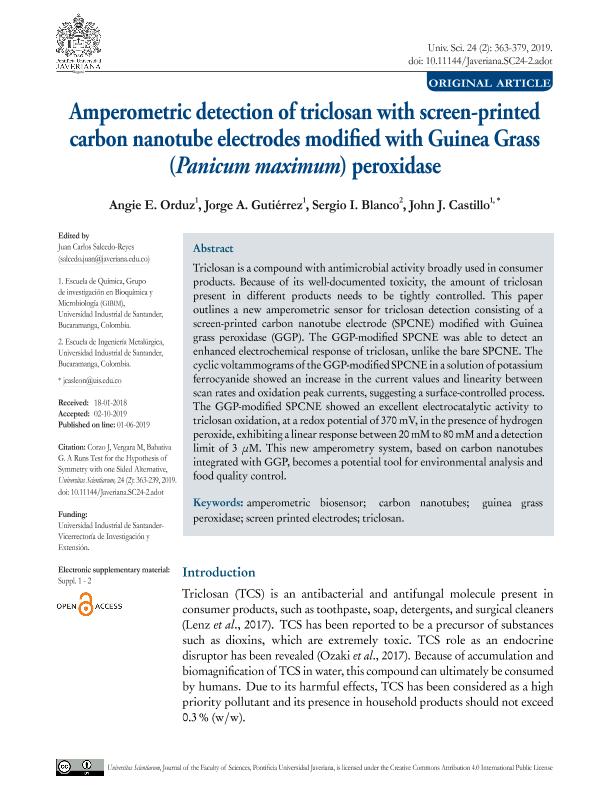Mostrar el registro sencillo del ítem
dc.contributor.author
Orduz Navas, Angie Estefany

dc.contributor.author
Gutiérrez, Jorge Andres
dc.contributor.author
Blanco, Sergio Ismael

dc.contributor.author
Castillo, John

dc.date.available
2020-12-15T16:04:25Z
dc.date.issued
2019-08-08
dc.identifier.citation
Orduz Navas, Angie Estefany; Gutiérrez, Jorge Andres; Blanco, Sergio Ismael; Castillo, John; Amperometric detection of triclosan with screen-printed carbon nanotube electrodes modified with Guinea Grass (Panicum maximum) peroxidase; Pontificia Universidad Javeriana; Universitas Scientiarum; 24; 2; 8-8-2019; 363-379
dc.identifier.issn
0122-7483
dc.identifier.uri
http://hdl.handle.net/11336/120468
dc.description.abstract
Triclosan is a compound with antimicrobial activity broadly used in consumer products. Because of its well documented toxicity, the amount of triclosan present in different products needs to be tightly controlled. This paper outlines a new amperometric sensor for triclosan detection consisting of a screen-printed carbon nanotube electrode (SPCNE) modified w ith Guinea grass peroxidase (GGP). The GGP-modified S PCNE was a ble t o d etect an enhanced electrochemical response of triclosan, unlike the bare SPCNE. The cyclic voltammograms of the GGP-modified SPCNE in a solution of potassium ferrocyanide showed an increase in the current values and linearity between scan rates and oxidation peak currents, suggesting a surface controlled process. The GGP-modified SPCNEs howed an excellent electrocatalytic activity to triclosan oxidation, at a redox potential of 370 mV, in the presence of hydrogen peroxide, exhibiting a linear response between 20 mM to 80 mM and a detection limit of 3 µM. This new amperometry system, based on carbon nanotubes integrated with GGP, becomes a potential tool for environmental analysis and food quality control.
dc.format
application/pdf
dc.language.iso
eng
dc.publisher
Pontificia Universidad Javeriana

dc.rights
info:eu-repo/semantics/openAccess
dc.rights.uri
https://creativecommons.org/licenses/by/2.5/ar/
dc.subject
AMPEROMETRIC BIOSENSOR
dc.subject
CARBON NANOTUBES
dc.subject
SCREEN PRINTED ELECTRODES
dc.subject
TRICLOSAN
dc.subject.classification
Físico-Química, Ciencia de los Polímeros, Electroquímica

dc.subject.classification
Ciencias Químicas

dc.subject.classification
CIENCIAS NATURALES Y EXACTAS

dc.title
Amperometric detection of triclosan with screen-printed carbon nanotube electrodes modified with Guinea Grass (Panicum maximum) peroxidase
dc.type
info:eu-repo/semantics/article
dc.type
info:ar-repo/semantics/artículo
dc.type
info:eu-repo/semantics/publishedVersion
dc.date.updated
2020-11-06T20:25:05Z
dc.journal.volume
24
dc.journal.number
2
dc.journal.pagination
363-379
dc.journal.pais
Colombia

dc.journal.ciudad
Bogotá
dc.description.fil
Fil: Orduz Navas, Angie Estefany. Consejo Nacional de Investigaciones Científicas y Técnicas. Centro Científico Tecnológico Conicet - Bahía Blanca. Instituto de Química del Sur. Universidad Nacional del Sur. Departamento de Química. Instituto de Química del Sur; Argentina. Universidad Industrial Santander; Colombia
dc.description.fil
Fil: Gutiérrez, Jorge Andres. Universidad Industrial Santander; Colombia
dc.description.fil
Fil: Blanco, Sergio Ismael. Universidad Industrial Santander; Colombia
dc.description.fil
Fil: Castillo, John. Universidad Industrial Santander; Colombia
dc.journal.title
Universitas Scientiarum
dc.relation.alternativeid
info:eu-repo/semantics/altIdentifier/url/https://revistas.javeriana.edu.co/index.php/scientarium/article/view/Javeriana.SC24-2.adot
dc.relation.alternativeid
info:eu-repo/semantics/altIdentifier/doi/https://doi.org/10.11144/Javeriana.SC24-2.adot
Archivos asociados
